
How NASA, Boeing's X-66A aircraft will make air travel sustainable
What's the story
An experimental airplane designed by NASA, in association with Boeing, has been designated X-66A by the US Air Force. The plane, which will be built under the space agency's Sustainable Flight Demonstrator project, will aid the US in fulfilling its goal of net-zero aviation greenhouse gas emissions. To note, NASA has been building a wide variety of X-planes since the 1940s.
History
What are X-planes?
Back in the 1940s, NASA's predecessor, the National Advisory Committee for Aeronautics, built an experimental airplane with US Air Force and Navy. It was called Bell X-1 and has been followed by several models to date, the latest being X-66A. X-plane status is given to revolutionary aircraft made for testing designs and technologies, which are then adopted into other aircraft.
Details
The X-66A will have sleek wings
The X-66A demonstrator airplane will flaunt a design called Transonic Truss-Braced Wing. To build the aircraft, NASA and Boeing will make several modifications to the MD-90 model, including wing and engine replacement, as well as shortening the fuselage. The final product will sport long, thin wings with engines placed beneath them and supported by a set of aerodynamic trusses.
Reason
Why is a demonstration required?
Roughly 2.5% of the global carbon emissions are from civil aviation. Of this figure, more than half the emissions are done by single-aisle airplanes. If commercial flights based on X-66A's technology come to fruition, the "decarbonization of aerospace" will be possible. Using airplanes based on Transonic Truss-Braced Wing configuration and advanced propulsion systems could also bring down fuel consumption by 30% compared to today.
Information
How much will the project cost?
For the latest X-plane project, NASA will contribute $425 million over the next seven years, in addition to its "technical expertise and facilities." Meanwhile, Boeing will invest $725 million toward the venture.
Official words
'X-66A will aid in shaping future of aviation'
"The X-66A will help shape the future of aviation, a new era where aircraft are greener, cleaner, and quieter, and create new possibilities for the flying public and American industry alike," said NASA administrator Bill Nelson. Meanwhile, associate administrator Bob Pearce claimed that "transformative aircraft concepts" like X-66A, will help the US in reaching its goal of net zero aviation emissions by 2050.